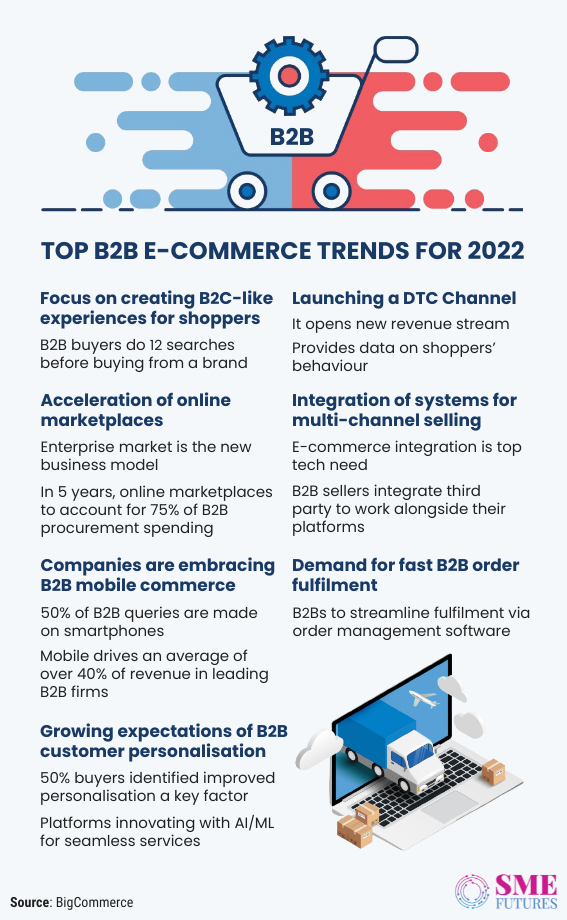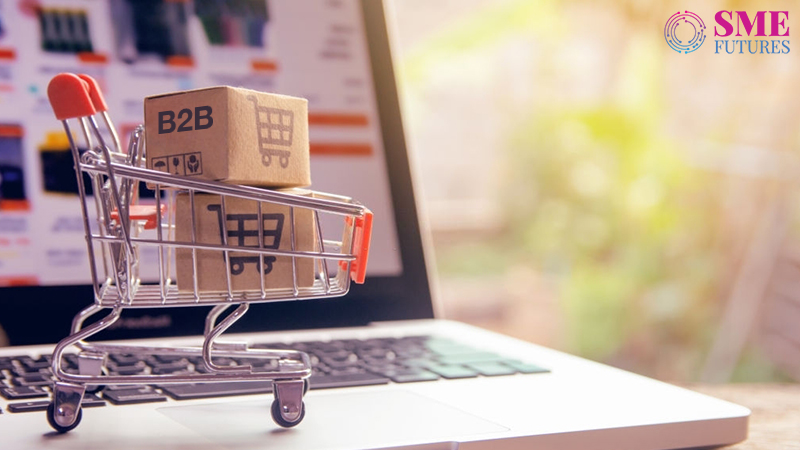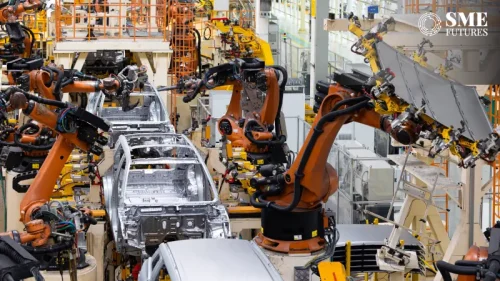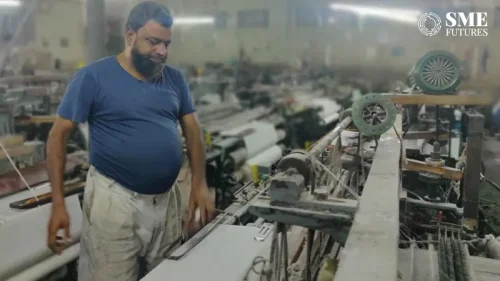The retail landscape has changed dramatically over the years. Consumers who used to go to their local kirana stores to shop can now get their groceries and other stuff delivered to them in a time frame of under 10 minutes to 2 hours through online platforms.
Suffice it to say that e-commerce has become synonymous with retail nowadays.
And without a doubt, it is penetrating the market at a faster rate than anticipated. According to an IBEF analysis, this sector in India is expected to reach US$ 111.40 billion by 2025, up from US$ 46.20 billion in 2020, at a 19.24 percent CAGR, with grocery, fashion, and lifestyle products serving as the key drivers of this growth.
This is primarily a business-to-consumer e-commerce scenario, which everyone is aware of. However, let’s talk about a different kind of retail, the business-to-business kind.
This is also known as wholesale. Wholesale typically means the sale of goods and merchandise to clients other than the end user and is largely a business-to-business operation. And the wholesaler acts as the intermediary between the manufacturer and the retailer.
For most of us, this is a behind-the-scenes concept of a retail shop, and is an intricate network of retailers, traders, distributers, and wholesalers. But with the emergence of e-commerce, even wholesalers and retailers have gone online for bulk buying and selling.
“B2B e-commerce has registered a 75 per cent growth over the last year,” says Rahul Goel, CFO at Moglix, a B2B marketplace for procuring industrial supplies.
In a couple of years his company has gained substantial ground in the B2B sector. Excited with the growth, Goel says that his company has many plans, “At Moglix, we are looking at a 20X growth of the SME business over the next 5 years. India will be going through the same rush in the B2B e-commerce segment as the B2C segment. With deeper penetration of smartphones among rural and suburban users and digital financing, India has a digital dividend,” he elaborates.
Another player, Lal10, a B2B platform for creative manufacturers feels that the presence of emerging online B2B marketplaces has become inevitable and irreplaceable.
“Because of this very reason we were able to provide a platform to a small copper-made toymaker of Bastar district in MP to sell his products to a retailer in Canada. This opportunity to become a global brand was accessible to only medium or large enterprises, but today even a micro-level or a small enterprise can onboard with us, and we can make it global,”
says Sanchit Govil, COO & Co-founder at Lal10, a B2B wholesale marketplace.
Govil’s platform currently has more than 1000 SMEs on board with around 20000+ SKUs live on the platform.
It’s convenient, say users
“Of course, one has to actively market and promote their products on the portals via advertisements and performance marketing techniques,” says Parimal Shah, founder & CEO at Cherise India.
His firm currently leverages the services of all the major B2B platforms of India. “We are observing excellent traction,” he says.
Online marketplaces are attracting business buyers because of their versatility, ease of use, and centralised payment options. You’ll need a powerful marketplace platform if you want to expand your company’s digital presence with a vertical or horizontal marketplace or if you want to enter the field as a stand-alone marketplace operator.
“The biggest benefit of B2B e-commerce is that it manages the supply chain more effectively as compared to traditional wholesale. It can provide a seamless platform where both suppliers and customers can enjoy a smooth flow of transactions with greater transparency. B2B e-commerce has also made the order fulfilment process faster,” elaborates Shah.
Similarly, Woodenstreet, an online furniture marketplace uses Udaan for further business traction. Virendra Singh Ranawat, its Co-founder tells us that digitising the sales channels with B2B forums has helped in optimising the supply chain and has increased their overall efficiency by around 30-40 per cent.
“Likewise, digitisation has helped to reduce the marketing overheads by around 42 per cent,” he tells us.
Advocating for the need for B2B platforms for businesses in today’s business scenario, he feels that B2B e-commerce offers innumerable benefits for the wholesalers, suppliers, and manufacturers as well.
“Through such robust platforms, businesses can reach out to a large number of new customers without incurring incremental costs. Likewise, they can penetrate new markets, geographies, and user bases. Simultaneously, going digital can also help in reducing the expenditures in traditional marketing and overheads, thereby boosting the overall bottom line,” he says.
From the internet to COVID—all are responsible
Gartner predicts that by 2025, 75 per cent of B2B sales organisations will augment their traditional sales playbooks with artificial intelligence (AI) guided selling solutions.
However, unlike B2B e-commerce, B2B marketplace or e-commerce was not a fad until recently. One of the possible reasons for this is that it is a highly unorganised sector. In fact, even though it is a potentially massive arena, companies such as Shotang have failed to maintain their presence in it.
But, in a few years, the tables have turned.
Perhaps as a result of the success of Indiamart or Udaan in the B2B marketplace sector, more and more companies have become aware of this potentially massive market. Companies like Ninjakart, IndustryBuying, Power2SME, Moglix, and others provide a one-stop marketplace for manufacturers, wholesalers, and retailers.
The factors that are driving e-commerce retail in India are also driving the growth in digital wholesale in the country.
Increased internet penetration powered by smart phones and the cheaper price of 4G internet, makes India one of the fastest e-commerce markets in the world. The COVID-19 crisis has also helped in engendering a widespread change in consumer behaviours and in making individual buyers comfortable with online ordering and enjoying its perks such as doorstep deliveries.
“Consumers, individual businesses, kirana shop owners, local shops etc. are also adopting the internet to boost their supply chains. Going digital is helping local shops and businesses to get access to a larger assortment of products, to enjoy discounts and to avail credit support alongside the seamless last mile delivery of products,” opines Ranawat.
Major wholesale e-commerce players such as Amazon, Flipkart Wholesale, Reliance Jiomart, etc. have witnessed a steep jump in their business in the recent quarters. For instance, in Jan-June 2021, Flipkart Wholesale registered a 100 per cent growth in its business, compared to the same period last year. It is eyeing even bigger growth numbers in the July- December time period.
“Due to COVID, we are observing a huge influx of wholesalers and small enterprises partnering with us because they have realized the radical positive change that B2B online wholesale can bring in their business,” says Govil citing COVID as a thrust factor.
But it needs to peak
According to Statista research, global B2B e-commerce was worth $14.9 trillion in 2020, more than five times the size of the B2C market.
Meanwhile, it states that the Asia Pacific region leads the way with a market share of nearly 80 per cent, leaving North America and Europe far behind, with Amazon and Alibaba playing the key roles in this scenario. But can we say the same about the Indian B2B e-commerce sector?
The experts are optimistic about the potential of the wholesale e-commerce sector, but they also feel that we are not there yet.
“Undoubtedly, it has a tremendous growth potential in India. The sector is touted to grow at a whopping 39 per cent year on year globally. This type of CAGR in this sector clearly signifies that wholesalers and customers are both starting to believe in the benefits of B2B e-commerce,” asserts Shah.
But there is a hitch. In Shah’s opinion, wholesale e-commerce is still at a very nascent stage in India.
“Though there has been significant growth in this sector, it still remains an underdog and is massively overshadowed as compared to retail e-commerce,” he says.
At the same time, Lal10’s Govil feels that in the coming years, wholesale e-commerce will witness unprecedented growth. Citing the example of his own platform, he says that the reason for this growth lies in the availability of the digital ecosystem for the wholesalers or businesses to promote and grow their business.
“We take care of order fulfilment and ensure smooth and transparent delivery services to our customers. Friendly payment terms, an automated buying process and vendor services compel customers and vendors to partner with us. Not just this, there is a greater opportunity in catering to small brands in the US, UK and Middle East with their frequent order cycles and the realisation of better margins,” says Govil.
Considering the better turnaround time and the bottom-line, Govil’s plan is to service 300 buyers globally with their home furnishing and decor products.
The audience is changing
Meanwhile, as the B2B e-commerce sector is gaining prominence within India Inc., its evolving on many other fronts as well.
One of the trends is that millennials are the new B2B buyers.
And as the B2B buyers are changing, the business process too has been upgraded from manual to digital. As per BigCommerce, a SaaS company focused on retailers, in 2020 close to half of B2B buyers were millennials — nearly double the amount from 2012.
“A Gen X buyer may prefer the handheld experience that a sales rep can provide but millennials expect that same personalised experience through streamlined, digital channels,” states BigCommerce. In addition to that, today’s B2B buyer conducts approximately 12 online searches before making a purchase from a specific brand. In response, 55 per cent of B2B marketing budgets are directed towards digital efforts that help provide a more personalised buying experience.
A B2B wholesale platform for creative manufacturers, Lal10 has been observing this trend first-hand. Agreeing with the BigCommerce findings, Govil says, “There is a significant surge in the number of first-generation small-medium buyers who are testing their entrepreneurial skills by starting their own businesses. Also, with climate change becoming one of the most pressing problems that the world is facing today, we are observing a greater number of customers asking for more eco-friendly and sustainable home furnishing and home décor items.”
There are more fascinating findings to share in the context of online retailing. To begin with, as many as 50 per cent of B2B companies prefer blogging as a marketing strategy, while 40 per cent prefer sending email newsletters and creating social media content. Print ads and brochures have been replaced by digital content marketing methods, and B2B audiences are discovering brands through a variety of channels.
Let’s have a look at this chart for the trends of 2022

Will e-commerce supplant traditional wholesale?
E-commerce has now become the norm in the retail business arena.
Technology has aided us in making the end-to-end supply chain transparent, effective, efficient, agile, and resilient. Technology has drastically improved the ease of doing business. Attending trade fairs or publishing a newspaper ad to market your products, have become things of the past. There is no doubt that e-commerce is going to gain increasing prominence and new trends will keep coming up in this sector whether it is B2B or B2C.
Now the pertinent question is that whether it’s going to end the traditional wholesale modes of doing business. The experts say that it’s highly unlikely. Yes, there is convenience with technology by your side, but the traditional methods will continue to exist, they opine.
“It would be wrong to say that online wholesaling will overshadow traditional wholesale because they both have their own significance,” opines Shah.
“But, in the era of the digital revolution, online wholesaling is indeed gaining a lot of traction. In companies too, the rate of social media presence and engagement in e-commerce has gone up tremendously in just a year and a half’s time. It was the need of the hour because online wholesaling provided the opportunity for accessing more buyers in one place and helped in expanding the market,” Shah adds.
Agreeing with this outlook, Govil says that with the help of online platform such as his, SMEs can easily digitise their operations at various levels. “They can make online inventories in the Karigar application which will help them cater to global enquiries. Further, the platform helps them to give product/design recommendations based on the latest market demands and trends. So online wholesale is propelling enterprises towards a fast-paced and responsive system,” he explains.
However, there are still some gaps in the e-commerce wholesale market which can be utilised and leveraged by online wholesale platforms to convert into opportunities.
As a user, Woodenstreet’s Ranawat still faces challenges while leveraging these platforms. But according to his perspective, it’s an evolving piece, and there is a lot to work on by spreading awareness so that businesses can utilise it. “One has to create a lot of awareness in the market. Likewise, you have to put extra efforts in terms of designing the customer lifecycle. Customer convenience and adding value to the end-user has to be the key,” he points out.
There are many ways to make wholesale e-commerce more friendly, more effective, more efficient, more robust, and more customer centric. As a solutions provider, Govil says that from a suppliers’ perspective, he believes that there has been a paradigm shift in the manner in which they used to conduct their business.
“There are opportunities in making the Indian artisans and small manufacturing units more technology-friendly, in making them more flexible in adapting design-related customisations and in enabling them to improve their productivity. From the buyers’ perspective, there are opportunities in adhering to stringent order delivery timelines, in the need for customer-specific pricing, and in managing huge product portfolios with slight design variations. These are definitely key improvement opportunities to successfully thrive in, in the online wholesale marketplace,” he says.
However, one thing is clear from an industry standpoint: With technology playing a critical role in the retail market, wholesalers are constantly innovating to make their B2B operations digital and seamless and are making it an inherent part of their operating models. As a result, they are pivoting in their growth.











